
If you’ve been reading here for awhile, you’ve seen this picture before—and others like it. My car, Wild Blue, has made many appearances here over the years, because she’s as much a character in my stories as any place I’ve visited.
In fact, she’s sometimes the star—though even when she isn’t, she’s never far from my mind.
She’s even made some cameos in my studio work.
She was the first and only car I’ve ever owned (thanks to years of living in dense cities, I didn’t need to buy one until my mid-twenties), and she took me nearly everywhere. I always thought I’d drive her to the moon, but it doesn’t matter that we fell a little short. She was the beating heart of my adventures, each highway another artery feeding our little love story.
Yet all stories have to end. Back in February I was gearing up for another big solo trip—a doozy this time, with 6500 miles of mostly remote mountain and desert roads. Blue already had many costly age-related repairs coming due, and I didn’t think she had another trip like that in her. So we took one last winding local drive together, and then I put her out to pasture.
Goodbye, Blue. Hello, Silver.
This new gal and I have had plenty of time to get acquainted—after all, she got well and truly broken in this spring with that big trip (more on that next time). And she’s the first car the Tailor and I have bought together, as we want to remain a one-car household. We had to make little compromises over what we each wanted, of course, but the biggest one was the compromise I had to make with the auto industry: I had to give up my stick shift. We really wanted this model, and a manual transmission simply isn’t an option anymore for this one.
For all I had to give up, and for all the frills and furbelows that seem to accompany all new cars (though I’ll admit I love having USB ports at last)—this car has plenty of qualities that fit my personality. No GPS, for one thing—you all know how I feel about that (the Tailor and I agreed that if that had come standard, we would have paid to have it removed!). And plenty of nooks and crannies for holding all my paints and things while I sketch.
Yet while Silver is pretty and sleek and reliable and powerful, she’s not my Blue. I’ve already put close to 10,000 miles on her, but I’m still finding it hard to make the transition. Driving an automatic feels so different to me, so less engaged. And I have a lot of trouble finding her in crowded parking lots—I’m usually great at remembering where the heck I parked, but finding a silver Subaru in a sea of other silver Subarus (welcome to the Northwest) is hilariously difficult. Still, I’m sure we’ll grow to know and trust each other over time. It’s just hard to give up your first love.
Thank you, Wild Blue, for taking me here, there and back again—and for always keeping me safe along the way.
Here’s to the next quarter of a million miles, and my shiny new steed. Hi ho, Silver.


















